Fit
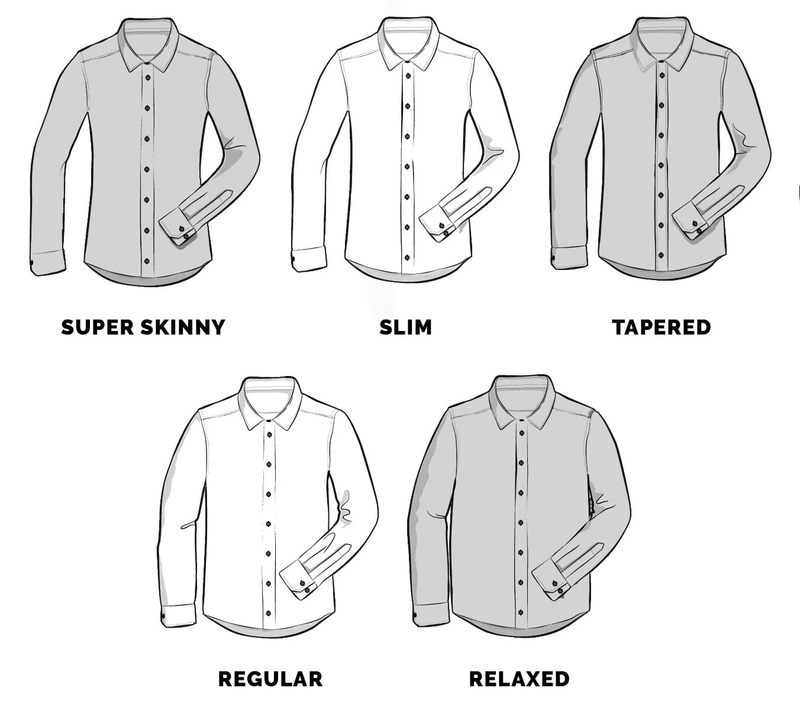

Men’s dress shirts come with or without a breast pocket.
• Formal shirt – No pocket.
• Casual shirts – Why not.
If you’re not going to use it, go without. Remember that shirts with breast pockets are unsuitable for the most formal events.
Placket
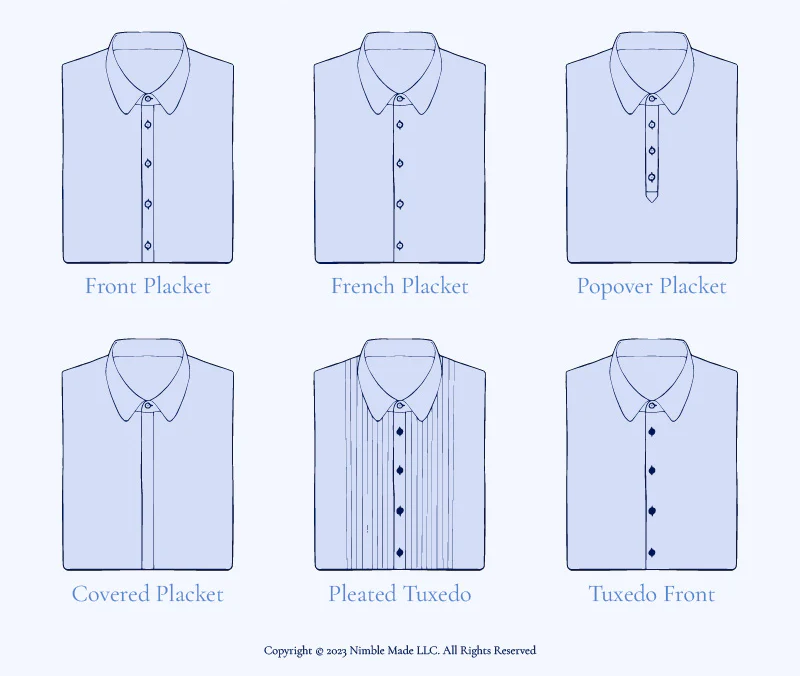
- Front placket (standard) – the most common type of placket in dress shirts. At 1-2 inches long, the fabric is either folded or attached as a separate piece (with visible stitches on both sides). It’s responsible for the symmetrical look of the front of your shirt.
- Covered placket (Concealed or Fly Front) – refers to a concealed shirt placket that has a flap on the front to hide the buttons beneath. This style is most appropriate for formal occasions where a tuxedo is required (since the fly front drives more attention toward the bow tie).
- French placket (No placket) – this is an alternative option for those who’d rather sport a plain shirt front. The edge of the front side of the shirt is folded over to form a creased edge (held together by the button holes). This style gives the dress shirt a simpler look and is considered more formal than the standard placket.
Fabric
Fabric Types
- Cotton – cotton is the standard by which other shirt fabrics are judged. It’s breathable, looks great and you can wash it over and over again without damaging it. You can also put it through the tumble dryer at a low heat.
- Synthetic – synthetic blends are common in men’s dress shirts, sometimes to add elasticity. The problem with synthetics is that they do not stand up to heat well. You need to take care to iron at a low temperature to avoid burning or melting the material. I avoid tumble drying synthetic shirts altogether and allow them to dry naturally. Note that synthetics are also prone to shrinking.
- Linen – linen is a lightweight and breathable material which makes it ideal for summer shirts. It’s a material best suited to a casual environment and tends to be more expensive than cotton or synthetic blends because its labor intensive production process.
Fabric Weight
Men’s dress shirts made from heavier fabrics will keep their form longer and are more suitable in cooler climates. Lighter shirts made from materials like Linen will keep you cool in the sun.
If you feel uncomfortable in your shirt, it will show – so make sure you pay attention to the fabric weight before making that purchase.
Thread Count
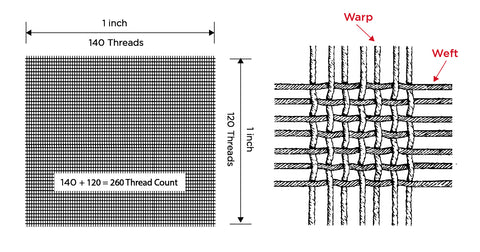
The total number of threads (warp + weft) per square inch of fabric (a “100-thread-count” fabric has 50 vertical (warp) and 50 horizontal (weft) threads per inch).
Higher thread count usually means a finer, smoother, and more luxurious feel (common in premium dress shirts). However, excessively high thread counts (e.g., 200+) can make fabric less breathable. Poplin typically has a high thread count (80–150), while Oxford is lower (60–80) for a more textured feel.
Cotton Count (Yarn Count, Ne)
Not to be confused with “thread count” (which is more often used to describe bedding than shirting fabrics), “cotton count” is the measure of how dense the thread is. The number represents the amount of material, measured in 840-yard hanks, needed to equal one pound.
The higher the number the finer the yarn, leading to some rough guidelines:
• 1-20 is a low cotton count usually referred to as a “coarse count.” It’s unlikely that you’ll find cloth made from coarse count thread in most custom tailors’ selections.
• 20-60 is a common range for single-knit T-shirts and similar lightweight cotton products. Off-the-rack dress shirts will often use threads from this range as well, though usually in double-knit cloths for added weight. The texture is plain and usually has a dull matte finish.
• 60-100 is a range of fine count cottons used for quality shirtings and bedsheets. The threads are much lighter and smoother, giving the finished cloth a slightly slippery feel and a bit of a reflective sheen.
• 100+ is very fine-spun cotton (usually from long-staple fibers) that makes an extremely light and smooth weave. The threads may be rather delicate because of their fineness, making the shirt less durable than most cotton garments.
Fabric Weave
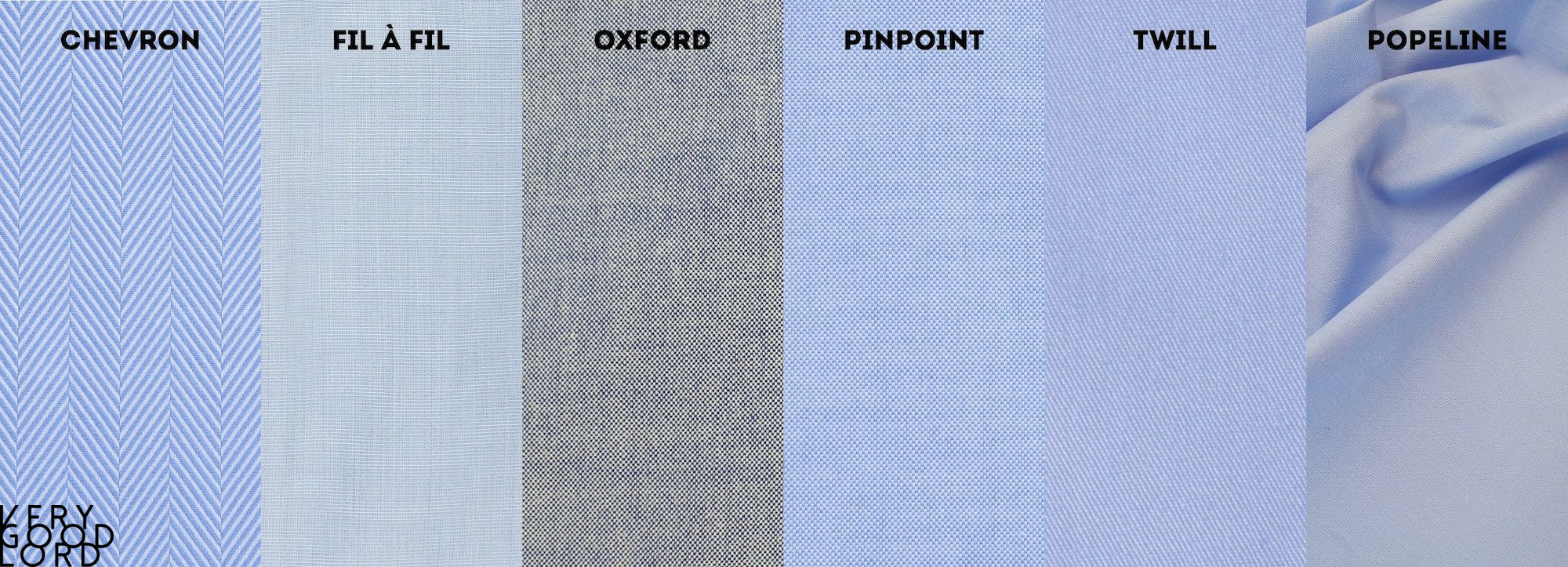
- Poplin (Popeline) – Soft and silky, it’s the most commonly used fabric for shirts. It’s usually made of cotton—but can also be wool or silk. It’s a smooth fabric with no visible texture in the weave, making it perfect for dress shirts.
- End-on-End (Fil-à-fil) – Used for solid-colored shirts, this fabric is similar to poplin but identifiable by the weft (horizontal) threads, which are a different color from the warp (vertical) threads.
- Oxford – A fabric that gives its name to a shirt style, it’s thicker than poplin. To the touch, it’s less smooth, with more texture due to its basketweave construction. It’s a perfect fabric for my casual shirts.
- Pinpoint – Very close to Oxford in its textured feel, though finer. It’s a soft yet durable fabric. The unique weave comes from dyed weft threads passing over two undyed warp threads, then under the next two. It’s a highly versatile fabric, and shirts made from it can be dressed up or down.
- Twill (Sergé) – With the same weave as denim, cotton twill is particularly appreciated for its durability, softness, and structure. You can recognize this fabric by its diagonal lines. A twill shirt is easy to iron, comfortable to wear, and gives a polished look.
- Herringbone (Chevron) – Similar to twill but with alternating diagonals that give the fabric a very chic look. It’s primarily used for dress shirts.
Pattern
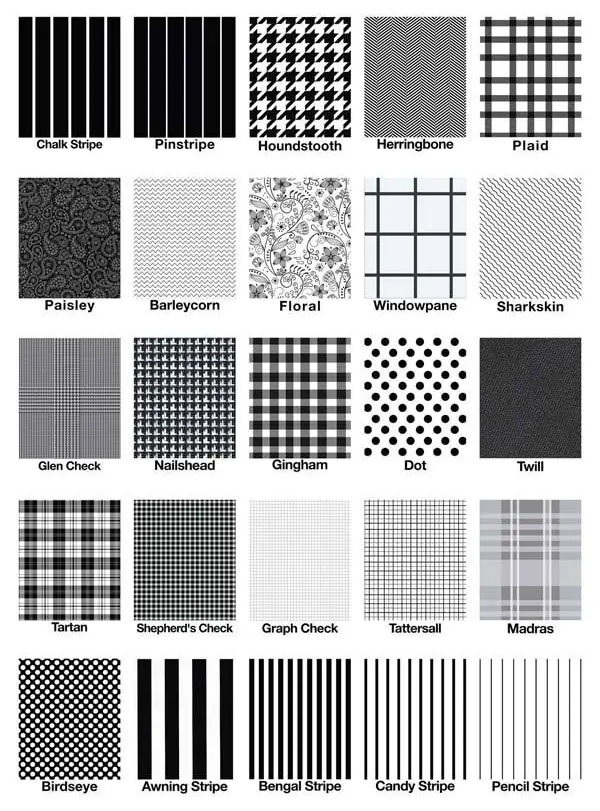
- Solid white/blue – for office/business attire and formal events
- Checked/striped pattern – suited to more social/casual environments with friends or family
- Multiple colors, bright colors, floral details – for weddings, informal dinner parties, afternoons at the beach (try incorporating this into your wardrobe during the summer)
Collar
Collar Design

- Collar Points – The tips of the collar.
- Collar Point Length – The distance from the Collar Points to where they meet the Collar Band.
- Collar Band – The piece of fabric that wraps around the neck.
- Collar Height – The height of a folded collar as it fits on the neck.
- Tie Space – The distance between the top of the folded collar parts where the shirt is buttoned.
- Collar Spread – The angle between Collar Points.
Types of Collars

Collar Stays
Collar stays, also called “collar tabs” or “collar stiffeners”, are flat, rigid pieces of plastic or metal which are inserted in special pockets on the underside of dress shirt collars.
The purpose of the collar stays is to keep the shirt collar in place by adding weight and crispness to an otherwise light and flexible piece of fabric.
Types of collar stays
• Removable
• Sewn-in: avoid as they may break due to thin plastic, can over time leave an impression in the collar points if over-ironed.
Material of collar stays
• Plastic: Plastic collar stays do their job to a degree, however, the plastic is light and flimsy. More often than not, the plastic is too light and too flimsy. You will find that even with plastic collar stays, your dress shirt collar will not lay correctly.
• Stainless steel: Stainless steel is the most popular metal for collar stays. Heavy and stiff, these collar stays will do their intended job. You can be sure that your dress shirt collar will lay correctly and look crisp. If you purchase stainless steel collar stays, some manufacturers give an option to personalize the metal collar stays.
More on collar stays: https://www.realmenrealstyle.com/collar-stays-dress-shirts/
Collar fitting
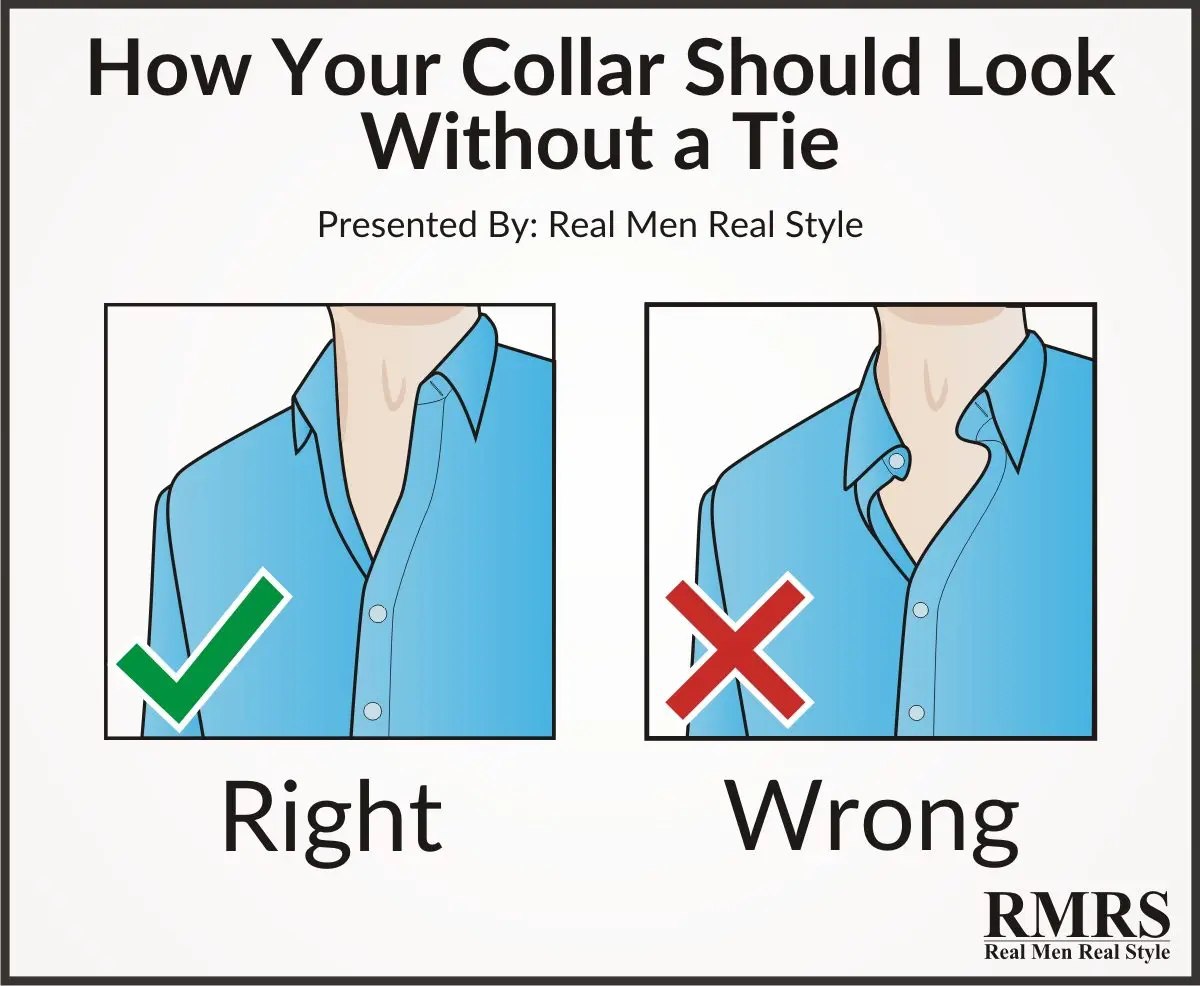
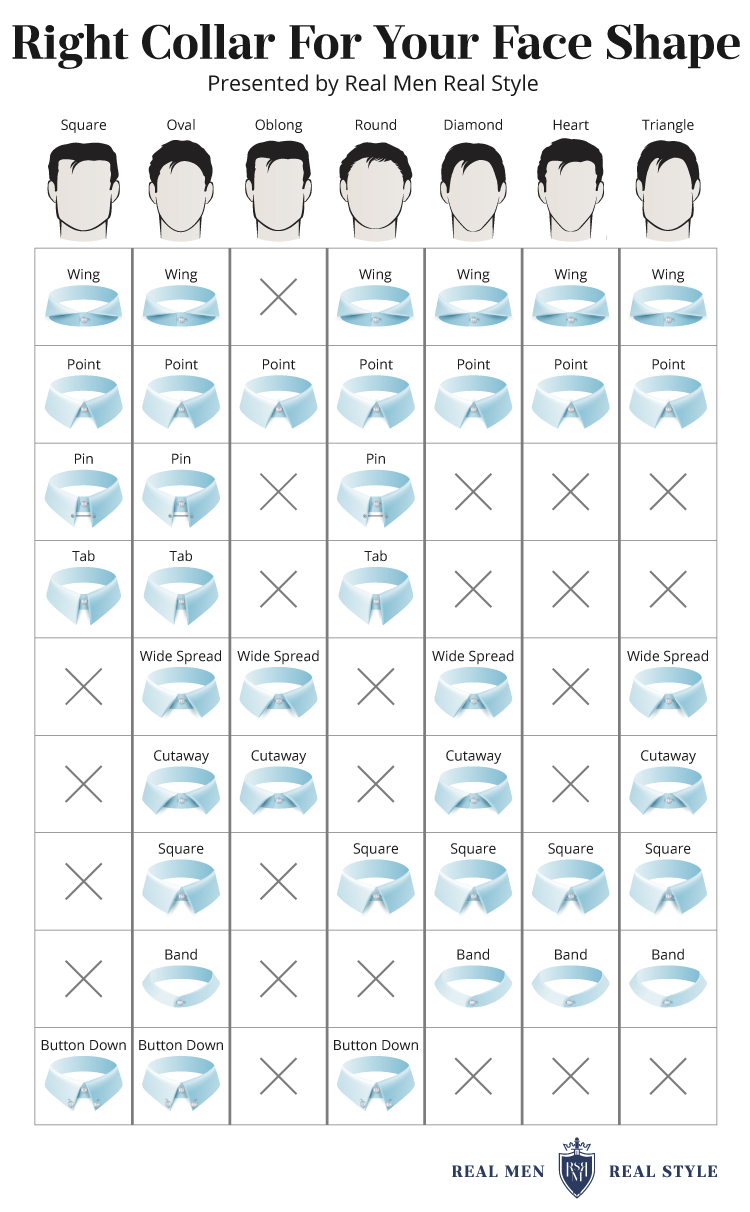
Buttons
- Plastic buttons – they’re common, fairly strong and affordable. However, if the manufacturer used low-quality resin in their construction, they can break easily. So there’s always a risk that comes along with them.
- Mother of Pearl buttons – these are the preferred type. Typically, they’re made from the shells that surround the pearl. That’s why they’re extremely resilient. But these buttons are also a bit pricier and suit higher-end clothes.
- Horn/Wooden buttons – durable alternatives for the buttons of casual shirts.
Cuffs
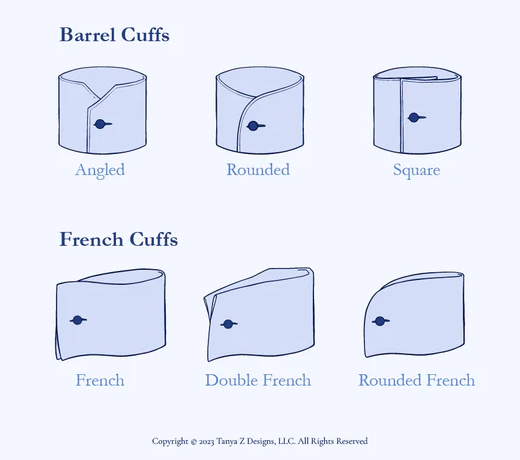
- 1-Button Barrel cuffs – the most common style that can feature round, square or angled corners. They wrap around the wrist and button into place. Round button cuffs promote a more casual feel and normally match with a button-down collar.
- 2/3-Button Barrel cuffs – a formal style where each cuff has 2-3 vertical buttons. Multiple buttons typically suit taller men. The larger barrel length also provides a nice snug fit around your wrist. This helps create a sharper look for more formal/professional settings.
- French cuffs – these are twice the length of regular cuffs. They’re designed to be folded back on themselves and sealed with cuff links. They’ve got a distinct look and pair well with a wing-tip collar style or a formal shirt. Use cufflinks for these.
More on cuffs: https://www.realmenrealstyle.com/mens-dress-shirt-cuffs/
Pleats
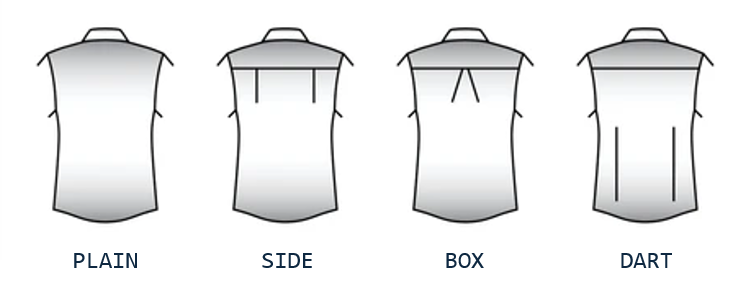
- Plain (No Pleat) – Not including pleats in your dress shirt gives it very clean lines and results in a sleek appearance. It also is tighter fitting because you get no extra movement from your dress shirt material. No back pleats is a contemporary shirt design and is very dressy.
- Side Pleats (Knife Pleats) – Rear side pleats sit directly under your shirt yoke near each shoulder blade. Each rear side pleat is half an inch wide, which gives the top of your dress shirt two inches of extra fabric, making it roomier in your chest area. This is an excellent pleat style for when you need to move your arms a lot. The pleats are hardly noticeable, creating a primarily smooth back of your dress shirt. They allow the fabric to drape and follow the curve of your back. Because of the subtlety of the rear side pleat, you’ll find it’s a nice style for your most professional business suits.
- Box Pleat – This pleat type is found mainly on store-bought button-up dress shirts. It’s a more casual styling for your shirt. Still, it is an acceptable pleat for dress shirts. The center box pleat is formed by two folds next to each other in the center of your shirt, right under the yoke; they are so close they seem to form a square. Each side of this pleat is ¾”, adding three extra inches of movement to your shirt fabric! If you tend to move a lot in your dress shirts, you will do well with this type of dress shirt pleat.
- Dart Pleats – Rather than expanding and providing more fabric, dart pleats take away some of your shirt fabric. A dart is created when the fabric is folded together and completely sewn down to the hem. It’s different from a pleat because a pleat is open at the bottom. The result is a slim and tapered waist, giving you less room for movement (slim-fit). This dress shirt style looks modern and quite structured.
More on pleats: https://askthegentleman.com/dress-shirt-back-pleat-types/
Fitting

Sources

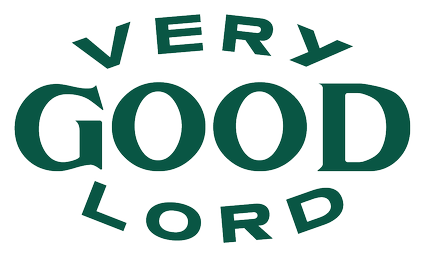
Leave a Reply